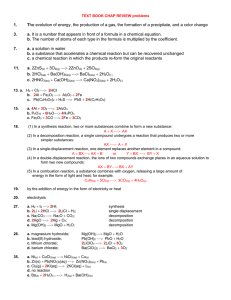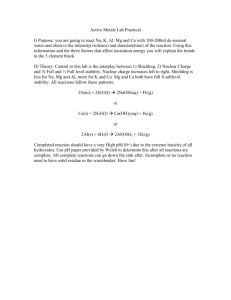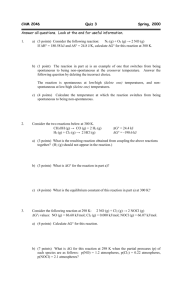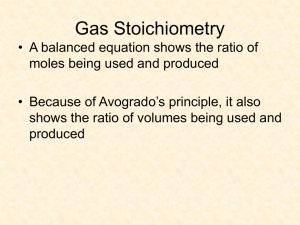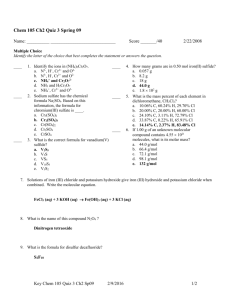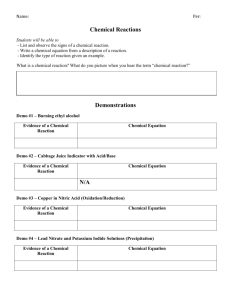Chapter 8 Chemical Reactions Chapter Review Answers 1. The
advertisement
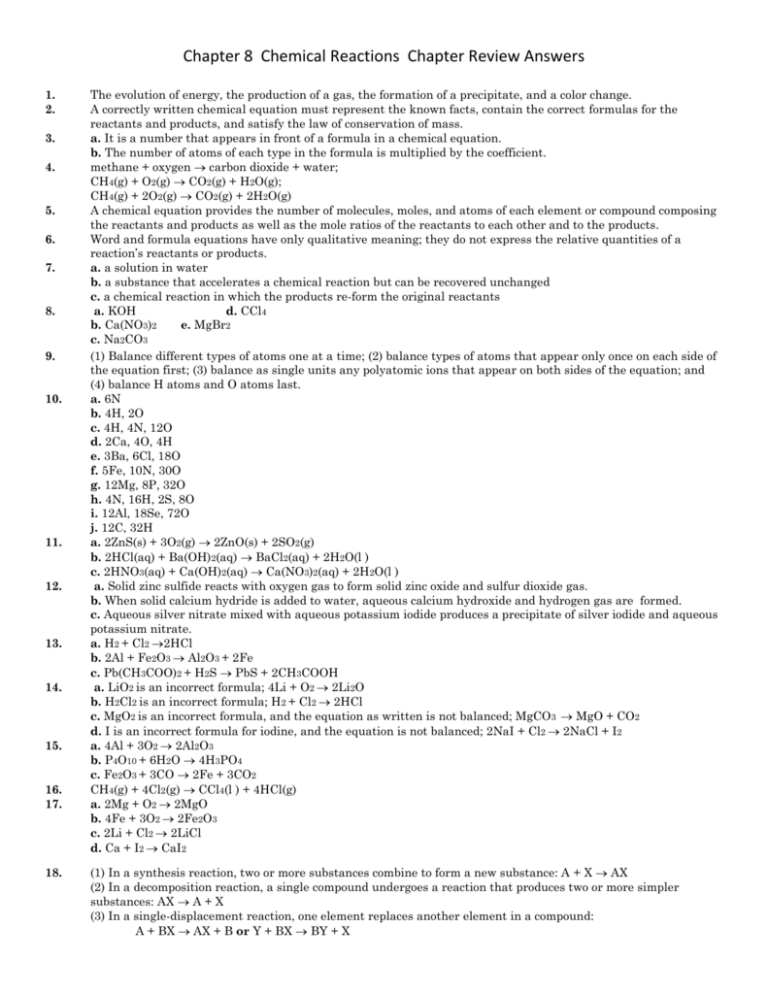
Chapter 8 Chemical Reactions Chapter Review Answers 1. 2. 3. 4. 5. 6. 7. 8. 9. 10. 11. 12. 13. 14. 15. 16. 17. 18. The evolution of energy, the production of a gas, the formation of a precipitate, and a color change. A correctly written chemical equation must represent the known facts, contain the correct formulas for the reactants and products, and satisfy the law of conservation of mass. a. It is a number that appears in front of a formula in a chemical equation. b. The number of atoms of each type in the formula is multiplied by the coefficient. methane + oxygen carbon dioxide + water; CH4(g) + O2(g) CO2(g) + H2O(g); CH4(g) + 2O2(g) CO2(g) + 2H2O(g) A chemical equation provides the number of molecules, moles, and atoms of each element or compound composing the reactants and products as well as the mole ratios of the reactants to each other and to the products. Word and formula equations have only qualitative meaning; they do not express the relative quantities of a reaction’s reactants or products. a. a solution in water b. a substance that accelerates a chemical reaction but can be recovered unchanged c. a chemical reaction in which the products re-form the original reactants a. KOH d. CCl4 b. Ca(NO3)2 e. MgBr2 c. Na2CO3 (1) Balance different types of atoms one at a time; (2) balance types of atoms that appear only once on each side of the equation first; (3) balance as single units any polyatomic ions that appear on both sides of the equation; and (4) balance H atoms and O atoms last. a. 6N b. 4H, 2O c. 4H, 4N, 12O d. 2Ca, 4O, 4H e. 3Ba, 6Cl, 18O f. 5Fe, 10N, 30O g. 12Mg, 8P, 32O h. 4N, 16H, 2S, 8O i. 12Al, 18Se, 72O j. 12C, 32H a. 2ZnS(s) + 3O2(g) 2ZnO(s) + 2SO2(g) b. 2HCl(aq) + Ba(OH)2(aq) BaCl2(aq) + 2H2O(l ) c. 2HNO3(aq) + Ca(OH)2(aq) Ca(NO3)2(aq) + 2H2O(l ) a. Solid zinc sulfide reacts with oxygen gas to form solid zinc oxide and sulfur dioxide gas. b. When solid calcium hydride is added to water, aqueous calcium hydroxide and hydrogen gas are formed. c. Aqueous silver nitrate mixed with aqueous potassium iodide produces a precipitate of silver iodide and aqueous potassium nitrate. a. H2 + Cl2 2HCl b. 2Al + Fe2O3 Al2O3 + 2Fe c. Pb(CH3COO)2 + H2S PbS + 2CH3COOH a. LiO2 is an incorrect formula; 4Li + O2 2Li2O b. H2Cl2 is an incorrect formula; H2 + Cl2 2HCl c. MgO2 is an incorrect formula, and the equation as written is not balanced; MgCO3 MgO + CO2 d. I is an incorrect formula for iodine, and the equation is not balanced; 2NaI + Cl2 2NaCl + I2 a. 4Al + 3O2 2Al2O3 b. P4O10 + 6H2O 4H3PO4 c. Fe2O3 + 3CO 2Fe + 3CO2 CH4(g) + 4Cl2(g) CCl4(l ) + 4HCl(g) a. 2Mg + O2 2MgO b. 4Fe + 3O2 2Fe2O3 c. 2Li + Cl2 2LiCl d. Ca + I2 CaI2 (1) In a synthesis reaction, two or more substances combine to form a new substance: A + X AX (2) In a decomposition reaction, a single compound undergoes a reaction that produces two or more simpler substances: AX A + X (3) In a single-displacement reaction, one element replaces another element in a compound: A + BX AX + B or Y + BX BY + X 19. 20. 21. 22. 23. (4) In a double-displacement reaction, the ions of two compounds exchange places in an aqueous solution to form two new compounds: AX + BY BX + AY (5) In a combustion reaction, a substance combines with oxygen, releasing a large amount of energy in the form of light and heat; for example, C3H8(g) + 5O2(g) 3CO2(g) + 4H2O(g) by the addition of energy in the form of electricity or heat electrolysis a. aqueous solutions b. They generally involve less energy than synthesis or decomposition reactions do. a. Sodium and oxygen react to form sodium oxide; 4Na + O2 2Na2O b. Magnesium and fluorine combine to form magnesium fluoride; Mg + F2 MgF2 ∆ a. 2HgO → 2Hg + O2 𝑒𝑙𝑒𝑐𝑡𝑟𝑖𝑐𝑖𝑡𝑦 b. 2H2O(l ) → 2H2(g) + O2(g) ∆ c. 2Ag2O → 4Ag + O2 𝑒𝑙𝑒𝑐𝑡𝑟𝑖𝑐𝑖𝑡𝑦 24. d. CuCl2 → Cu + Cl2 a. Zn + Pb(NO3)2 Pb + Zn(NO3)2 b. 2Al + 3Hg(CH3COO)2 3Hg + 2Al(CH3COO)3 25. 26. 27. 28. 29. 30. 31. 32. 33. 34. 35. 36. c. 2Al + 3NiSO4 3Ni + Al2(SO4)3 d. 2Na + 2H2O 2NaOH + H2 a. AgNO3(aq) + NaCl(aq) NaNO3(aq) + AgCl(s) b. Mg(NO3)2(aq) + 2KOH(aq) Mg(OH)2(s) + 2KNO3(aq) c. 3LiOH(aq) + Fe(NO3)3(aq) Fe(OH)3(s) + 3LiNO3(aq) a. CH4 + 2O2 CO2 + 2H2O b. 2C3H6 + 9O2 6CO2 + 6H2O c. C5H12 + 8O2 5CO2 + 6H2O a. H2 + I2 2HI; synthesis b. 2Li + 2HCl 2LiCl + H2; single displacement c. Na2CO3 Na2O + CO2; decomposition d. 2HgO 2Hg + O2; decomposition e. Mg(OH)2 MgO + H2O; decomposition a. magnesium hydroxide; Mg(OH)2 MgO + H2O b. lead(II) hydroxide; Pb(OH)2 PbO + H2O c. lithium chlorate; 2LiClO3 2LiCl + 3O2 d. barium chlorate; Ba(ClO3)2 BaCl2 + 3O2 Ni(ClO3)2 NiCl2 + 3O2 a. oxygen, carbon dioxide; C3H8 + 5O2 3CO2 + 4H2O b. pentane; C5H12 + 8O2 5CO2 + 6H2O c. oxygen, carbon dioxide, water; C2H5OH + 3O2 2CO2 + 3H2O a. Zn + S ZnS; synthesis b. AgNO3 + KI AgI + KNO3; double displacement c. C7H8 + 9O2 7CO2 + 4H2O; combustion d. C9H20 + 14O2 9CO2 + 10H2O; combustion a. the element’s ability to react b. For metals, the activity describes the element’s ability to lose electrons. For nonmetals, it describes the ability to gain electrons. a. a set of elements listed according to the ease with which the elements undergo certain chemical reactions b. Elements are usually listed in order of their tendency to undergo single-displacement reactions. An element in such a series can replace any element listed below it. a. The activity series of metals is based on the ease with which metal atoms lose electrons to form ions in aqueous solution; the higher a metal is in the series, the more easily its atoms lose electrons and the greater its reactivity. b. The greater the distance is, the greater the likelihood that one metal will replace the other in a reaction. a. K b. Al c. Cr d. F e. Ag f. Cl g. Sr h. F a. Ni(s) + CuCl2(aq) NiCl2(aq) + Cu(s) b. Zn(s) + Pb(NO3)2(aq) Zn(NO3)2(aq) + Pb(s) c. Cl2(g) + 2KI(aq) 2KCl(aq) + I2(s) d. No Reaction e. Ba(s) + 2H2O(l) H2(g) + Ba(OH)2(s) a. 2Ca(s) + O2(g) 2CaO(s) b. 2Ni(s) + O2(g) 2NiO(s) c. No Reaction 37. 38. 39. 40. 41. 42. 43. a. 4.0 mol NH3, 2.0 mol N2, & 6.0 mol H2O b. 6.0 mol O2, 4.0 mol N2, & 12.0 mol H2O c. 2.0 mol NH3, 1.5 mol O2, & 3.0 mol H2O d. 0.27 mol NH3, 0.20 mol O2, & 0.13 mol N2 a. Potassium and chlorine react to form potassium chloride; 2K + Cl2 2KCl b. Hydrogen and iodine react to produce hydroiodic acid; H2 + I2 2HI c. Magnesium and oxygen react to produce magnesium oxide; 2Mg + O2 2MgO Pt 𝑒𝑙𝑒𝑐𝑡𝑟𝑖𝑐𝑖𝑡𝑦 2NaCl(aq) + 2H2O → 2NaOH(aq) + H2(g) + Cl2(g) a. Ca(OH)2 + (NH4)2SO4 CaSO4 + 2NH3 + 2H2O b. 2C2H6 + 7O2 4CO2 + 6H2O c. 2Cu2S + 3O2 2Cu2O + 2SO2 d. 2Al + 3H2SO4 Al2(SO4)3 + 3H2 a. 4Al(s) + 3O2(g) 2Al2O3(s) b. No Reaction a. (NH4)2S(aq) + ZnCl2(aq) 2NH4Cl(aq) + ZnS(s); Double-Displacement Reaction b. 2Al(s) + 3Pb(NO3)2(aq) 3Pb(s) + 2Al(NO3)3(aq); Single-Displacement Reaction c. Ba(s) + 2H2O(l) Ba(OH)2(aq) + H2(g); Single-Displacement Reaction d. Cl2(g) + 2KBr(aq) 2KCl(aq) + Br2(l); Single-Displacement Reaction 𝑃𝑡 44. 45. 46. 47. e. 4NH3(g) + 5O2(g) → 4NO(g) + 6H2O(l); Combustion Reaction (Ex. Without Carbon) f. 2H2O(l) 2H2(g) + O2(g); Decomposition Reaction a. Cu(s) + Cl2(g) CuCl2(s); Synthesis Reaction b. Ca(ClO3)2(s) CaCl2(s) + 3O2(g); Decomposition Reaction c. 2Li(s) + 2H2O(l) 2LiOH(aq) + H2(g); Single-Displacement Reaction d. PbCO3(s) PbO(s) + CO2(g); Decomposition Reaction 12.3 mol HCl H2O a. nothing, 2, nothing, 2 b. nothing, 12, 12, 11 c. 2, 3, nothing, 6
